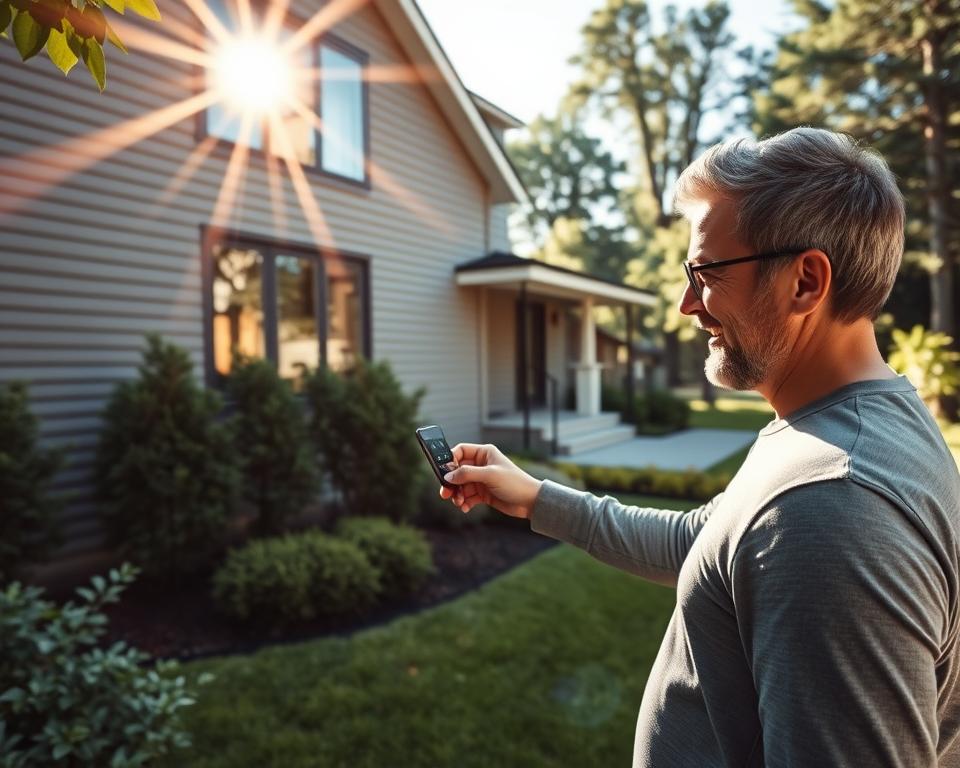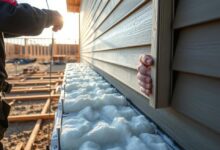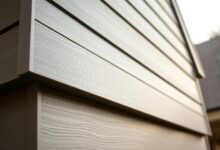The Best Insulated Siding to Boost Your Home’s Energy Savings
Homeowners are always looking for ways to cut down their energy bills and make their homes more comfortable. One great way is to install energy-efficient siding. This can really help save energy at home.
Insulated siding adds an extra layer of protection against the weather. It keeps your home warm in winter and cool in summer. This reduces the work your heating and cooling systems have to do.
This not only cuts down on energy use but also helps the planet. With many options out there, picking the right insulated siding is key for those wanting to make their homes more energy-efficient.
Key Takeaways
- Energy-efficient siding can significantly reduce energy bills.
- Insulated siding provides an additional layer of protection against the elements.
- It helps minimize the strain on heating and cooling systems.
- Choosing the right siding is critical for improving home energy efficiency.
- Many insulated siding options are available for homeowners.
Understanding Insulated Siding and Its Energy Benefits
More homeowners are choosing insulated siding to cut down on energy use. But what makes siding “insulated,” and how does it save energy?
What Makes Siding “Insulated”
Insulated siding has a layer of insulation on the back. This layer stops heat from moving between the outside and inside of the house. It makes homes more energy-efficient. The insulation is usually foam plastic, which is very good at keeping heat out.
R-Value Explained: The Measure of Insulation Effectiveness
The R-value shows how well insulation works. A higher R-value means better insulation. Insulated siding’s R-value depends on the insulation type and thickness.
Traditional vs. Insulated Siding Comparison
Insulated siding is different from traditional siding in many ways. It’s more energy-efficient, which can save a lot of money. It also lasts longer and is quieter than other siding types.
Insulated siding has many benefits:
- Enhanced energy efficiency
- Improved durability
- Reduced noise pollution
The Best Insulated Siding for Energy Savings
Choosing the right insulated siding is key to making your home more energy-efficient. It not only makes your home look better but also keeps it cooler in summer and warmer in winter.
Insulated Vinyl Siding Options
Insulated vinyl siding is a top pick for many homeowners. It’s durable and helps save energy. Two standout products are:
ProVia Spectrum Insulated Vinyl Siding
ProVia Spectrum offers style, durability, and energy savings. Its insulated core has a high R-value, cutting down on heat loss.
CertainTeed CedarBoards Insulated Siding
CertainTeed CedarBoards combines traditional looks with modern energy efficiency. Its insulated backing reduces heat transfer, saving energy.
Insulated Fiber Cement Siding
Fiber cement siding is tough and stands up to the weather. Adding insulation makes it even better for saving energy.
James Hardie Insulated Backing Systems
James Hardie’s insulated systems boost fiber cement siding’s energy efficiency. They help close thermal gaps and increase the R-value.
Insulated Steel and Aluminum Siding
Steel and aluminum siding with insulation are durable and energy-saving options.
Alside Prodigy Insulated Siding
Alside Prodigy combines insulated siding with steel or aluminum durability. It’s energy-efficient and can match many home styles.
| Siding Type | R-Value | Durability | Cost |
|---|---|---|---|
| Insulated Vinyl Siding | 2.5-3.5 | High | Moderate |
| Insulated Fiber Cement Siding | 3.0-4.0 | Very High | Higher |
| Insulated Steel/Aluminum Siding | 3.5-5.0 | High | Higher |
By picking the right insulated siding, you can make your home more energy-efficient. This means lower energy bills and a more comfortable home.
How to Evaluate Insulated Siding Performance
When looking at insulated siding, there are key factors to consider. These factors affect how well it saves energy. Homeowners need to think about different things to choose the right siding.
Energy Star Ratings and Certifications
Energy Star ratings are very important. Energy Star is a program run by the U.S. Environmental Protection Agency. It shows if siding meets energy-saving standards. Look for Energy Star certified siding to cut down on energy use.
Climate Zone Considerations for Siding Selection
Where you live also matters. Different places have different weather. For example, very cold or hot areas need siding that can handle it. The Department of Energy’s climate zone map helps find the right siding for your area.
| Climate Zone | Recommended Insulated Siding | Energy Savings |
|---|---|---|
| Northern States | Insulated Vinyl Siding | Up to 30% energy savings |
| Southern States | Insulated Fiber Cement Siding | Up to 25% energy savings |
Real-World Energy Savings Examples
Many homeowners have saved a lot of energy with insulated siding. For example, in the northern U.S., people saved up to 30% on heating costs with insulated vinyl siding.
Installation Guide for Maximum Energy Efficiency
Getting your insulated siding installed right is key to saving energy. A good installation means your siding works well, keeping your home comfy and energy-efficient.
Pre-Installation Home Assessment
Before you start, check your home’s condition. Look for water damage, rot, or structural problems. Make sure walls are straight and even. Any issues can hurt your siding’s energy-saving abilities.
Proper Installation Techniques
To save energy, follow these tips:
- Make sure windows, doors, and other openings are sealed tight.
- Use the right fasteners to hold the siding in place.
- Align the siding right to avoid gaps and overlaps.
Common Installation Mistakes to Avoid
Watch out for these common errors:
- Not using enough flashing in vulnerable spots.
- Measuring and cutting siding panels wrong.
- Not following the manufacturer’s instructions.
DIY vs. Professional Installation Considerations
DIY can save money, but think about your skills and the job’s complexity. Professional installers offer a warranty-backed, top-notch job.
| Installation Method | Pros | Cons |
|---|---|---|
| DIY Installation | Cost savings, personal control | Potential for errors, lack of warranty |
| Professional Installation | Warranty-backed, high-quality finish | Higher upfront cost, less personal control |
Cost Analysis and Return on Investment
Insulated siding has many benefits, but its cost and return on investment (ROI) are key. Homeowners need to look at both the upfront cost and long-term savings. This helps figure out if this energy-saving option is worth it.
Initial Investment vs. Long-Term Savings
The cost of insulated siding is usually higher than other siding types. But, the long-term energy savings can make up for this. Insulated siding can lower heating and cooling bills by making your home more energy-efficient.
Tax Credits and Incentives for Energy-Efficient Siding
Many governments give tax credits and incentives for energy-saving upgrades like insulated siding. These can lower the cost you pay upfront.
Financing Options for Insulated Siding Projects
There are financing options to help pay for insulated siding. You can get home equity loans or special energy-efficient financing programs.
| Financing Option | Interest Rate | Repayment Term |
|---|---|---|
| Home Equity Loan | 4.5% | 10 years |
| Energy-Efficient Financing | 3.9% | 15 years |
Combining Insulated Siding with Other Energy Improvements
Homeowners can boost energy efficiency by pairing insulated siding with other energy-saving steps. This combo can greatly enhance a home’s energy use.
Window and Door Upgrades
Improving windows and doors is key to better energy efficiency. New, energy-smart windows and doors cut down on heat loss and air leaks. They work well with insulated siding to save more energy.
Attic Insulation Synergy
Insulated siding and attic insulation together make a home more energy-efficient. Good attic insulation keeps heat in winter and out in summer. Insulated siding stops energy loss through walls. They form a strong defense against energy loss.
Creating a Complete Thermal Envelope
The aim of energy-saving home upgrades is a complete thermal envelope. This means sealing all gaps and insulating the home’s exterior well. By using insulated siding, attic insulation, and upgrading windows and doors, homes become more energy-efficient.

Conclusion: Making the Right Choice for Your Home
Choosing the best insulated siding for your home is key. It can greatly affect your energy savings and home improvement. Knowing the different types and their benefits helps you make a smart choice.
Think about your needs and budget when picking the right siding. Adding insulated siding to your home can make it more energy-efficient. This can also increase your home’s value.
Investing in top-notch insulated siding brings long-term benefits. You’ll save on energy bills and live in a more sustainable home. Start making your home more energy-efficient by looking into insulated siding options today.




